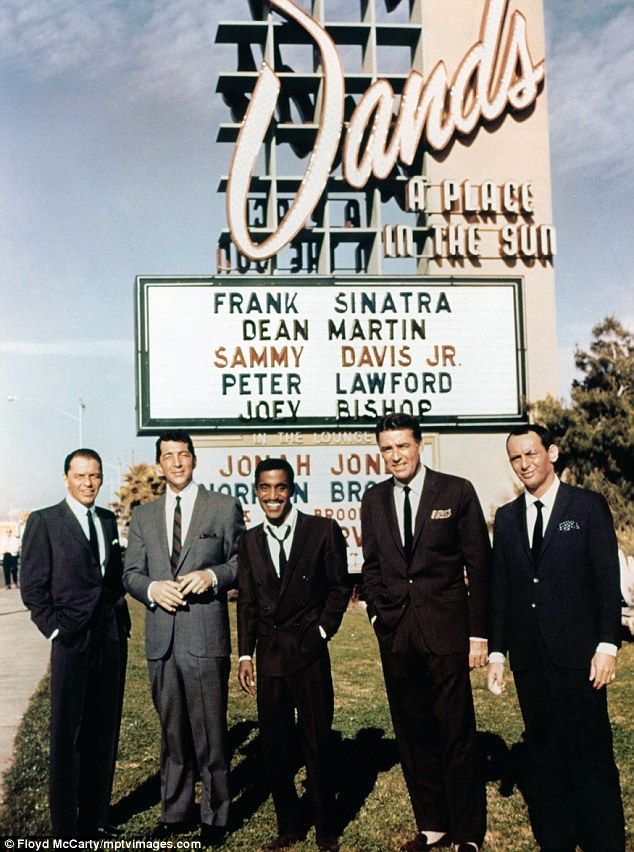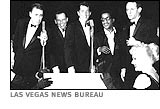

How The Sands hotel secured The Rat Pack
In 1960, an unlikely group of entertainers, all loosely gathered around Frank Sinatra, went to Las Vegas to shoot a movie and do two nightclub shows each evening, spending most of the hours in between at all-night parties. Billed, with intentional swagger, as “the Summit” (a reference to the coming conference of Eisenhower, de Gaulle, and Khrushchev), their stage act took off like a rocket, its momentum carrying them beyond the three-week club date into movie and record and business deals, reprises in Miami, Atlantic City, and Palm Springs — power and influence unusual even for movie stars.
The Rat Pack announced that a new generation was laying claim to American tradition and to the right to define American Cool: one black, one Jew, two Italians, and one feckless Hollywoodized Brit, three of them second-generation immigrants, four raised during the Depression in ethnic city neighborhoods. Successful, self-assured, casual, occasionally vulgar, they were sign and symptom of what the war had done to the American WASP class system. The Rat Pack were more than entertainers, and the Summit was more than a stage act. It was a giddy version of multiethnic American democracy in which class was replaced by “class.”
Sinatra and Martin and the Rat Pack exuded machismo and danger, a style lent authority by their known associations with powerful and violent men. Postwar Americans had learned to take their popular culture spiked with a touch of risk, and Sinatra had molded his adult image on the sensitive tough guys portrayed in the movies by Humphrey Bogart.
Bogart in fact is central to Rat Pack history. In 1949 Sinatra had moved his family from L.A.’s Toluca Lake to Holmby Hills, just blocks from Bogart’s house, and the Hollywood rookie was inducted into a group of the film star’s drinking buddies. The story goes that when Bogart’s wife, Lauren Bacall, saw the drunken crew all together in the casino, she told them, “You look like a goddamn rat pack.”
Sinatra liked having people around him, and after Bogart died in 1957, he assembled his own court.
Joey Bishop, who grew up Joseph Gottlieb in South Philadelphia, the son of a bicycle repairman, was known as the Frown Prince of Comedy for his world-weary style.
Singing with the Dorsey band in 1941, Frank had befriended the aspiring dancer, Sammy Davis, Jr., then part of the Will Mastin Trio; they reconnected after Sammy was discharged from the army,
Dean Martin had come up as a singer very much in Sinatra’s mold. By the early fifties, the fellow Capitol recording artists had grown close, and they sealed their friendship in 1958 on the set of Some Came Running, which also featured the future Rat Packette Shirley MacLaine.
In January 1959, Frank Sinatra joined Dean Martin for the first time on the stage of the Sands, setting the tone and format for the Rat Pack shows. Variety reported: “Frank Sinatra joined his Great & Good friend [Dean Martin] onstage, and the pair put on one of the best shows ever seen at the Sands.”
It was a good thing, for the Sands, for Las Vegas, for the people whose money built all those modernistic hotels. Earlier that month Fidel Castro had marched into Havana and seized casinos that earned the mob millions annually. The pressure was now on Las Vegas, where the mob-with financing courtesy of the Teamsters Central States Pension Fund-had in the course of the 1950s invested in such new hotels as the Fremont and the Dunes. The Sands was the classiest, and it offered incentives to hold on to top talent. In 1958 Sinatra’s percentage in the hotel and casino was raised from two to nine points, and Dean Martin was sold a point. With Davis and Bishop already signed to long-term contracts, the Sands was the de facto home of the Rat Pack well before the Summit.
 The fifth member of the Pack, suave, London-born Peter Lawford, was an actor and entertainer who had landed a contract with MGM when he was twenty but never broke into serious leading roles. By the late fifties he wasn’t doing much, but he had other assets — his wife was Jack Kennedy’s sister Pat. Sinatra clearly relished the Kennedy connection; his Rat Pack nickname for Peter was Brother-in-Lawford.
The fifth member of the Pack, suave, London-born Peter Lawford, was an actor and entertainer who had landed a contract with MGM when he was twenty but never broke into serious leading roles. By the late fifties he wasn’t doing much, but he had other assets — his wife was Jack Kennedy’s sister Pat. Sinatra clearly relished the Kennedy connection; his Rat Pack nickname for Peter was Brother-in-Lawford.
The Sands entertainment director agreed to a format for the Summit that fitted its improvisatory informality. For two shows each evening, at least one, perhaps two or three or four, sometimes all five entertainers, would appear on the Copa Room’s stage. Although February was traditionally a slow month, the hotel received eighteen thousand reservation requests for its two hundred rooms. Word traveled fast about the Summit’s wildness-hijinks partially scripted and anchored by the emcee, Bishop, whom Sinatra called “the hub of the big wheel.” Between star turns by Martin, Davis, and Sinatra, and dance numbers with Davis and Lawford, they wandered off to the wings, parodied each other, did impressions, and poured drinks from a bar cart they rolled onstage.
They performed together, drank together, hung out together, and the press couldn’t get enough of them. At first they were called the Clan, over heavy protests. Sinatra said, “It’s just a bunch of millionaires with common interests who get together to have a little fun.” Bishop frowned: “Clan, Clan, Clan! I’m sick and tired of hearing things about the Clan. Just because a few of us guys get together once a week with sheets over our heads…” Sammy Davis, straight-faced: “Would I belong to an organization known as the Clan?”
The Rat Pack is remembered for their style, their irreverent humor, their boozy and fleshy private lives, and their leader’s occasional thuggish arrogance. But in their time they meant something else too, something that had everything to do with the expectations and aspirations of their audience. The key was ethnicity and the special role it played in postwar America.
The Rat Pack show, unlike pre-war entertainment, featured — even flaunted — race and ethnicity. Bishop, dressed as a Jewish waiter, warns the two Italians to watch out “because I got my own group, the Matzia.” The night JFK showed up ringside, Dean picked Sammy up in his arms and held him out to the candidate: “Here. This award just came for you from the National Association for the Advancement of Colored People.” Sammy: “I’m colored, Jewish, and Puerto Rican. When I move into a neighborhood, I wipe it out.”
The act worked because each of them projected a different attitude toward aspiration and its success: Frank was the embodiment of slum kid become American classic; the others were foils. Dean, with what Variety called his “somebody wrote this song so I might as well sing it” attitude, suggested to the audience that the whole American success thing was a racket. Joey warded off envy with classic Jewish self-deprecating irony. Sammy, with his heartbreakingly perfect accent, turned every number into a drama of aspiration, giving everything to win over the audience, to have it accept and love him despite his race; the message was about overcoming odds. And Peter was the ultimate foil: he stood for the elegant but desiccated Anglophilic WASP culture whose day was over. For ethnic Americans, the Rat Pack looked both back to the past and forward to the future, offering at once reassurance and exhilaration: a past of the guys on the block, coming up the hard way, ethnic jokes and attitudes; a future of complete assimilation, wealth, swinging fun, and acceptance — the giddy, disorienting flight to American success.
There’s irony in the fact that the Rat Pack, like the cocktail and the cigar, has lately been taken up as an emblem of a new political incorrectness. The drinking, the smoking, the swinging insouciance seem like a vacation from the economic and political pressures of nineties America. But there is more to the Rat Pack than adolescent swagger, more even than the sharp-edged dash of their masculine style, though they had plenty of both. For a few short years America’s greatest entertainers kidded and sang their way through our last cultural consensus.
